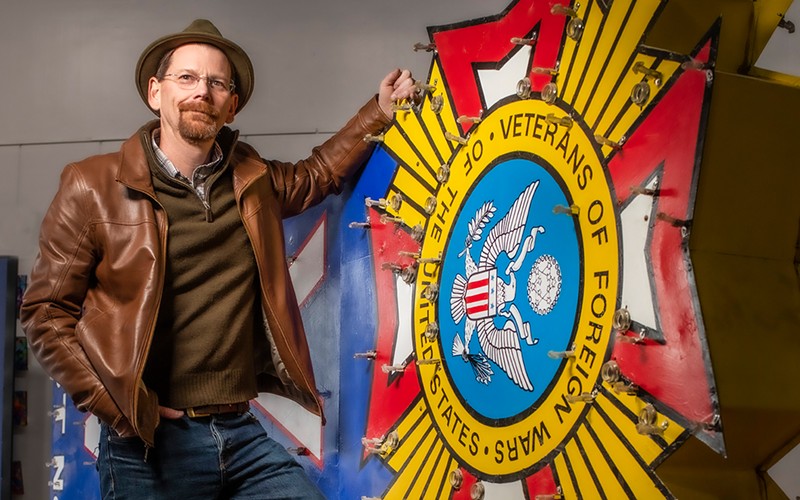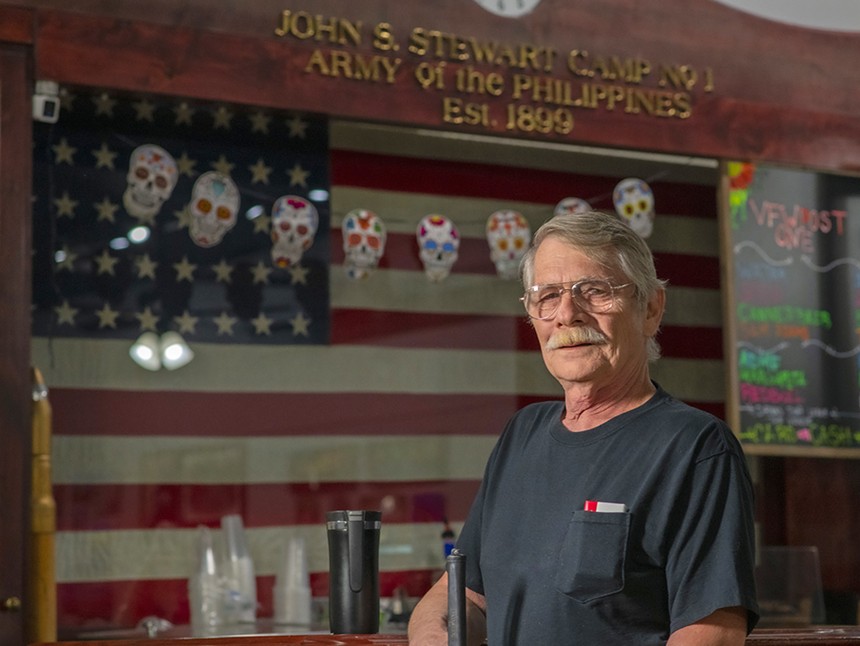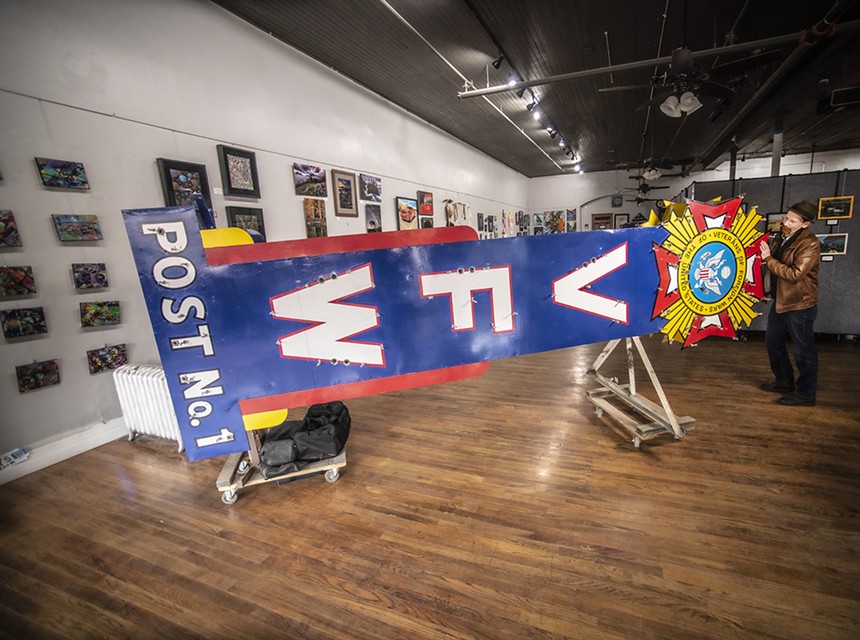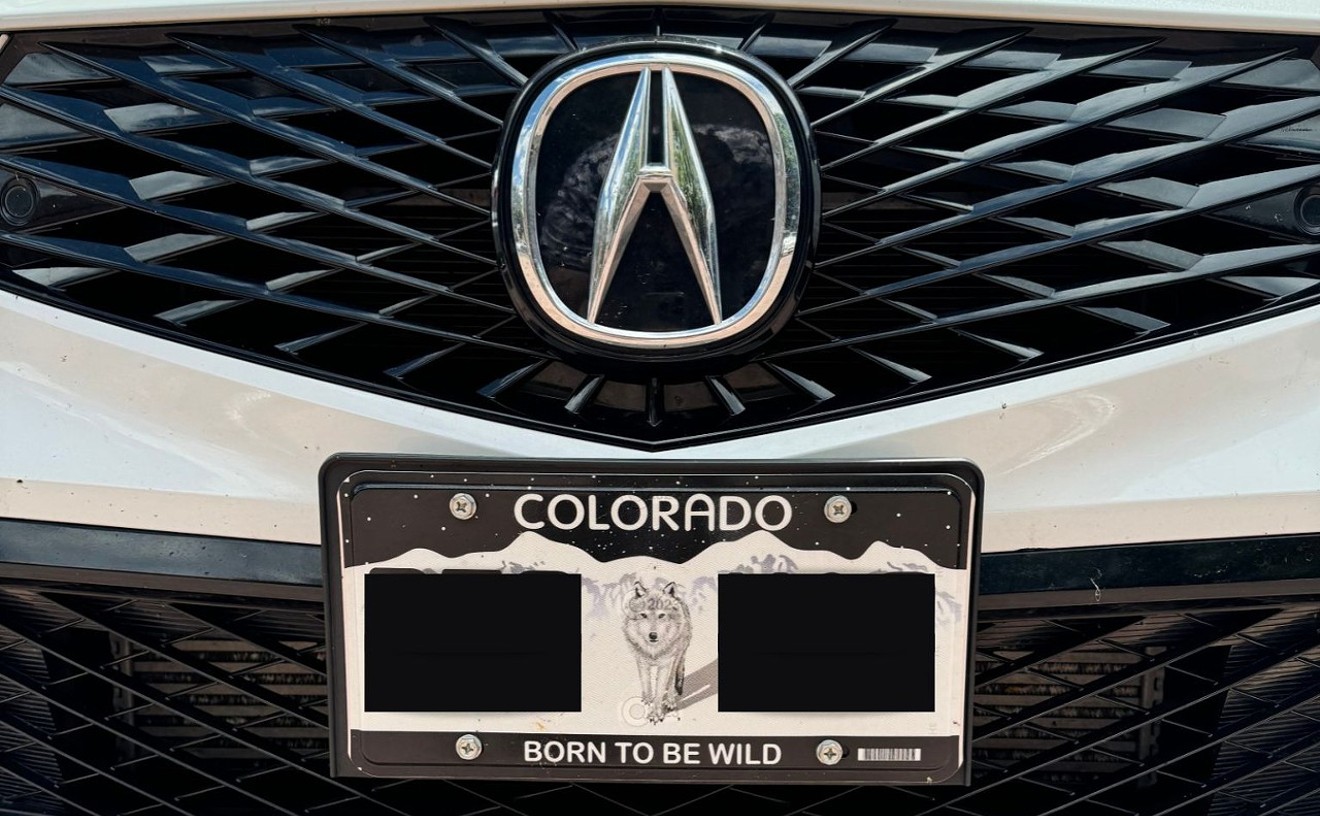In 1949, Denver illuminated another first for a city booming in the wake of World War II. A glowing red, blue and yellow neon sign lit up a building at 901 Bannock Street, proclaiming that it was the Veterans of Foreign Wars Post 1.
But it would take a hard-fought recent campaign by local veterans to make sure that honor didn't become history.
In 1899, soldiers who'd served in the Spanish-American War returned to Colorado from the Philippines. Many had trouble adapting to life back home and found comfort in connecting with other veterans.
General Irving Hale, who'd led the First Colorado state militia in the war (Camp Hale, which trained troops in mountain warfare during WWII, was named after him), enlisted other soldiers who'd returned to the state and formed the Society of the Army of the Philippines John S. Stewart Camp 1, after the first Coloradan to die in the Spanish-American War.
The inaugural meeting of the Army of the Philippines took place in the basement of the Colorado Capitol on December 1, 1899, and the original bylaws were written at the Brown Palace on August 12, 1900.
Fifteen years later, the Army of the Philippines in Denver merged with an organization based in Ohio and Pennsylvania, the American Veterans of Foreign Service, creating the Veterans of Foreign Wars national organization. Denver's post was given the title the Veterans of Foreign Wars John S. Stewart Post 1.
Soon other VFW groups were springing up around the country. In 1915 the VFW had around 5,000 members; in 1936 it received its congressional charter, a symbolic recognition from the United States government. In 1946, after the end of WWII, membership spiked to 1.5 million.
Post 1 met at various places throughout Denver for the first four decades after its founding, finally buying the building at 901 Bannock Street in the 1940s, as an army of servicemen who'd returned from the war sought out a place to gather with other vets. By 1949, John S. Stewart Post 1 had 2,461 members, still the highest enrollment in its history.
"The post was rolling in money," remembers John Holland, the oldest living member of VFW Post 1. A Chinese restaurant, the Lotus Room, had a window that opened into the post; diners would order drinks from the bar to enjoy with their meal. Slot machines in the basement of the post kept more money rolling in.
But then the post hit hard times. During the ’60s and ’70s, opposition to the Vietnam War caused many to drop their memberships; still other vets didn't join at all. When the owner of the Chinese restaurant died, bar sales fell off. And in 1990, Colorado voters approved allowing limited-stakes gaming in Black Hawk, Central City and Cripple Creek; by the next year, the post had lost gambling as a source of revenue, too.
Unable to keep up the spot at 901 Bannock, the post traded that building to a developer for a smaller property at 955 Bannock Street in the mid-1990s.
In 2002, Michael Mitchel, a Navy veteran of the Persian Gulf War, drove by 955 Bannock and saw the neon sign; he wondered if it was truly the first VFW post in the country. He stopped in, verified that it had earned its number-one label, and became a member. After that, he'd often stop in for a warm meal and conversation, but membership in the club was definitely dwindling. In December 2002, the doors were locked.
Despite its status as a founding member, the post's charter was suspended by the state VFW. Engagement was low, and the post often didn't have the six people needed to constitute a quorum at meetings, officials pointed out; there wasn't enough money to keep the place open.
If a VFW post charter is revoked, all of the assets of the VFW go to the state VFW and members become "at large" members. "Part of the reason the charter got suspended was because of a six-figure debt," Mitchel recalls. "It’s part of our history, and you have to own that."
Members were worried about losing more than their charter: They wanted to hold on to their status as the number-one post. "When your charter is suspended, the state comes in and takes over, and they manage it while the post reorganizes," Mitchel notes. "If you don’t come out of the suspension of the charter, then all the assets go to the state. In the VFW system, the numbers are unique, so there’s only one Post 1."
If the post couldn't find its way out of suspension quickly enough, that number might have gone back into circulation. And even if it was able to get back on solid footing with the VFW, it might have become something like Post 6,000 instead of number one, since there are currently around 6,000 posts around the world, 87 of them in Colorado, six in Denver.
The neon sign might have gone dark permanently.
The post's auxiliary, originally established in 1914 as the ladies' auxiliary, started fundraising. "Financial problems befell us, and the ladies' auxiliary bolstered our economy...the finances were aided," Holland says. With the auxiliary's help, the post's suspension was lifted by the fall of 2003, but it still needed to fix its finances or risk another suspension — or worse, a possible revocation of the charter.
In 2007, the post sold the 955 Bannock building, which had become a money pit. Everything was put in storage, including the iconic neon sign, while meetings bounced from location to location, including places like the Denver Press Club.
In 2013, Mitchel became commander of the post and led a merger of Post 1 with VFW Post 6616 to bolster membership. With money from the sale of 955 Bannock, in 2014 the post purchased a 131-year-old building in the Art District on Santa Fe, at 841 Santa Fe Drive, that had been an auto parts store, then an art gallery, for $650,000. Mitchel started the VFW 1 Foundation to raise money for renovation projects, including replacing the roof, fixing the bathrooms and making the place compliant with the Americans With Disabilities Act. "We’ve been chipping away at it ever since," he says.
From the start, the post encouraged art projects in its new building. Curtis Bean, an Iraq veteran, had started a program called The Art of War with the Denver Vets Center, and brought it to the post. Since the Art of War worked with non-combat veterans and civilians, too, it soon moved off the post and into RedLine Contemporary Art for a while, but its legacy remained.
Veteran Jim Stevens joined the post in 2015, he and Mitchel decided to create their own program, the Veterans Arts Council, with Stevens as director. Stevens, who is legally blind after suffering a stroke caused by a bullet fragment left after he was shot in the head in Vietnam, creates portraits from painted fishing line.
"We’re not an art therapy program; we’re the next step," Stevens says. "We established an art gallery at the post — that was one of the first things we did, and we have an open call for art on the second Saturday of every month. Civilians and veterans can bring their art into our gallery."
If a veteran's work is not quite ready to be shown in the post's gallery, the VFW will set the vet up with a mentor to help.
While Stevens worked on the art program, Mitchel continued to push renovation plans. "When you buy your home, you know you need to fix it up. We didn’t realize how much it [was] going to take," Mitchel says.
While COVID put a halt to construction projects in 2020 — and the post itself shut down — work started again in February 2021, after the post received $60,000 from the Bonfils-Stanton Foundation, $57,737 from the Kyle Clark Word of Thanks Micro Giving, and a host of other donations. But what "really put them over the finish line," according to Mitchel, was the $868,000 received from a 2022 Colorado Community Revitalization Grant.
Using American Rescue Plan funds provided for COVID relief, the Colorado Legislature has approved close to $100 million for revitalization grants over the past two years through Colorado Creative Industries and the state Office of Economic Development.
In order to be eligible for a grant, a project generally has to involve a creative or historic space, submit plans that include a high level of community engagement and respond to community needs, have the potential to stimulate the local economy and attract other funding, be able to be completed in a reasonable amount of time, and meet energy efficiency standards.
Mitchel and Stevens, the post's current executive director, sat down and wrote the narrative for a community revitalization grant about a year and a half ago, when they saw that applications were open. Without it, Stevens says, the post wouldn't be nearly where it is today.
"The revitalization grant has allowed us to really get phase one of our remodeling completed in a way that we never could have without it," Stevens says. "The grant was so important because...not only have we made it ADA-compliant, our bathrooms are new, our access is new.... The grant has really helped our veterans."
The building will still be getting an elevator that can hold one person in a wheelchair as well as a few other amenities, but it's well beyond where it was when the post bought it.
VFW Post 1 reopened in August. There's a beautiful art gallery in the front; hidden away in the back are various rooms that still need to be refurbished into potential office space or art studios. A large wooden bar sits in the middle of the building, embellished with the words "John S. Stewart Camp No. 1; Army of the Philippines; Est. 1899." Next to the bar hangs the post's original charter with the names of the founding members. The 120-year-old document is spattered with something Mitchel says he hopes are coffee stains.
The post no longer has an official bar; Mitchel calls it a saloon, and while it doesn't have a regular liquor license, the post can get permits for special events. Today it's a family-friendly space full of healing and educational activities. It hosts First Friday events, yoga classes, post-traumatic stress disorder therapy and other activities. "People don’t want to come to a bar; that’s just not the demographics of this generation’s veterans," Mitchel says.
A large reason that the arts program is necessary is because of the mental health struggles that veterans face, according to Stevens. "Art causes a lot of introspection; there’s a feeling involved that works, and it’s been proven to work in overcoming things like PTSD," he says. "Every year, I’ve had either a veteran in our program or a spouse tell me that if it hadn’t been for the Veterans Arts Council, they would have committed suicide or their spouse would have committed suicide."
With its art program and gallery space, VFW Post 1 is now a significant part of Denver's most notable art district, with large crowds coming through on First Friday art walks to look at work created by vets, including Stevens.
"Now that we've reopened, my job is to try and bring everybody back into the community," he says.
But they have to find their way to the post without the help of the iconic neon sign.
After the post left 955 Bannock, the sign went into storage. Then a new owner took over the storage company and the sign got lost for years, until someone who does restoration work found it and let the VFW know it still existed.
That was last year, and today the sign is stored in the post's new home. The building isn't structurally sound enough yet to display it; the brick walls need to be shored up. And then the post will need to get permission to hang a neon sign.
"Once we’re ready to go to the city, we’ll have to see what the city says, but hopefully we’ll be satisfying our requirements in getting our sign back up," Stevens says.
Denver requires zoning permits for signs located on private property that extend over a public sidewalk, particularly if it might interfere with a pedestrian's use of the sidewalk. In any case, a building and electrical permit will be required.
The building will have to follow specific zoning code rules for the district. The neon lights themselves are fine as long as they don't exceed 25 watts per bulb, according to Amanda Weston, communications manager for Community Planning and Development. They can also be in a variety of colors, though flashing, animated and internally illuminated signs are prohibited.
Once the VFW turns in a permit application, the Department of Transportation and Infrastructure will have to review the sign to make sure it follows the rules.
As Mitchel stands in VFW Post #1, sharing its long history, he lets out a deep breath, one that he's seemingly held since the chapter's suspension. Twenty years ago, he came for the grilled cheese and the $1.25 Jack and Coke, but he stayed for the community and ultimately helped make this post what it is today.
"You know what NAVY stands for?" asks the vet. "Never again volunteer yourself."
[
{
"name": "Air - MediumRectangle - Inline Content - Mobile Display Size",
"component": "12017618",
"insertPoint": "2",
"requiredCountToDisplay": "2",
"watchElement": ".fdn-content-body",
"astAdList": [
{
"adType": "rectangle",
"displayTargets": "mobile"
}
]
},{
"name": "Editor Picks",
"component": "17242653",
"insertPoint": "4",
"requiredCountToDisplay": "1",
"watchElement": ".fdn-content-body",
"astAdList": [
{
"adType": "rectangle",
"displayTargets": "desktop|tablet"
},{
"adType": "rectangle",
"displayTargets": "desktop|tablet|mobile"
}
]
},{
"name": "Inline Links",
"component": "18838239",
"insertPoint": "8th",
"startingPoint": 8,
"requiredCountToDisplay": "7",
"maxInsertions": 25
},{
"name": "Air - MediumRectangle - Combo - Inline Content",
"component": "17261320",
"insertPoint": "8th",
"startingPoint": 8,
"requiredCountToDisplay": "7",
"maxInsertions": 25,
"watchElement": ".fdn-content-body",
"astAdList": [
{
"adType": "rectangle",
"displayTargets": "desktop|tablet"
},{
"adType": "rectangle",
"displayTargets": "desktop|tablet|mobile"
}
]
},{
"name": "Inline Links",
"component": "18838239",
"insertPoint": "8th",
"startingPoint": 12,
"requiredCountToDisplay": "11",
"maxInsertions": 25
},{
"name": "Air - Leaderboard Tower - Combo - Inline Content",
"component": "17261321",
"insertPoint": "8th",
"startingPoint": 12,
"requiredCountToDisplay": "11",
"maxInsertions": 25,
"watchElement": ".fdn-content-body",
"astAdList": [
{
"adType": "leaderboardInlineContent",
"displayTargets": "desktop|tablet"
},{
"adType": "tower",
"displayTargets": "mobile"
}
]
}
]


















